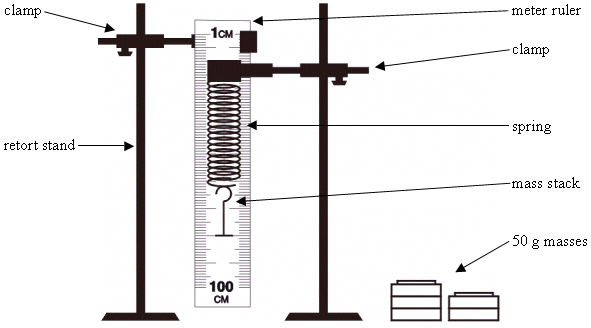Springs II
| 1. |
Carrying Out and Recording
|
||||||||||||||
|
Springs will stretch if a force pulls on them. The amount of stretch depends upon the size of the force.
Your task is to find how a spring stretches as masses are added to it.
Carrying Out - set up the experiment. An example of a possible set up is shown in the diagram below:
 |
|||||||||||||||
| a) |
What is the reading for the spring length on the meter ruler before the mass stack is attached?
Spring length = __________
|
||||||||||||||
| b) |
i) Add the mass stack, how long is the spring now? __________
ii) By how much longer is the spring (stretch)? __________
|
||||||||||||||
| c) |
Add a 50 g mass. Record the reading on the meter ruler and the stretch of the spring.
mass __________ spring length __________ stretch __________
|
||||||||||||||
| d) |
Repeat for 4 other masses. Record your experimental data in the box below.
|
||||||||||||||
| e) | Recording - Record your experimental data in the table below. | ||||||||||||||
|
|||||||||||||||
| 2. | Processing and Interpreting | |||||||||||||||
Processing - A Year 10 class carried out an investigation to find out if the compression of a spring was linked to the size of the mass put on it.
 Their results are shown in the table below.
On the axes below, draw a graph for these results. Remember to think about:
 |
||||||||||||||||
| Interpreting - Use your graph to answer the following questions. | ||||||||||||||||
| a) |
What is the height of the spring if a 5 kg mass is added? __________ cm |
|||||||||||||||
| b) |
What mass would be needed to make a spring have a height of 12.3 cm? __________ kg
|
|||||||||||||||
| c) |
Complete this sentence: Each time a mass of 1 kg is added, the height of the spring reduces by
__________ cm.
|
|||||||||||||||
| 3. | Planning |
A group of students decided to find out if the amount of stretch of a spring was effected by the thickness of the spring. Plan an experiment to test their idea. Remember to think about:
|
|

